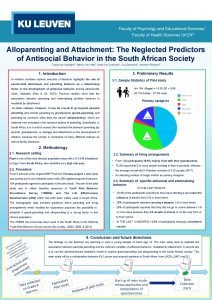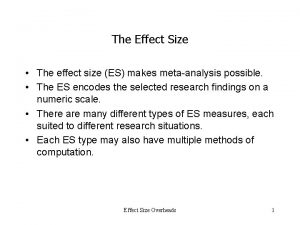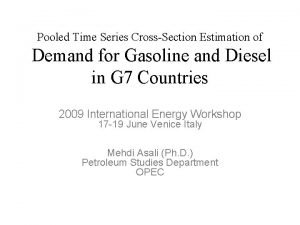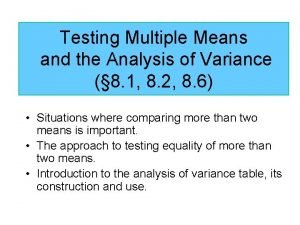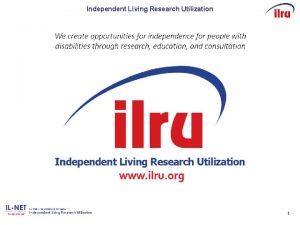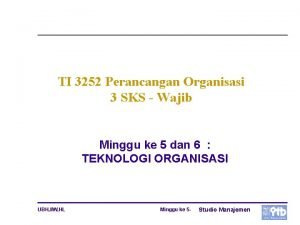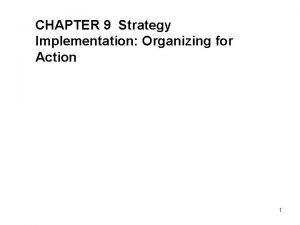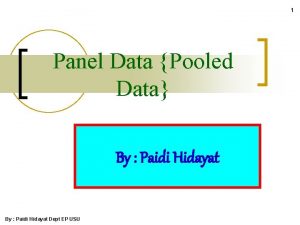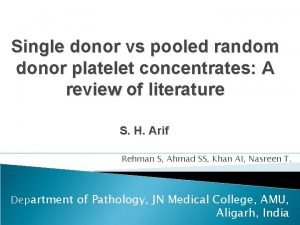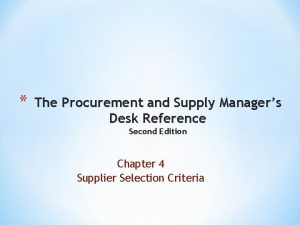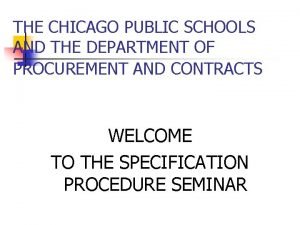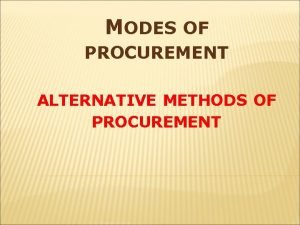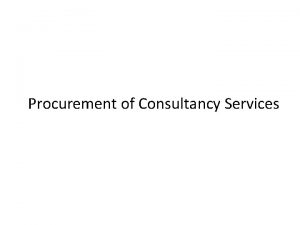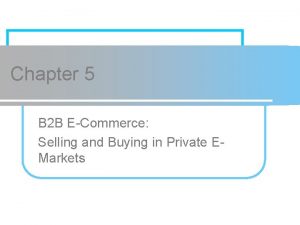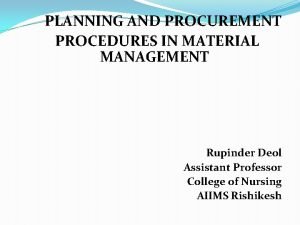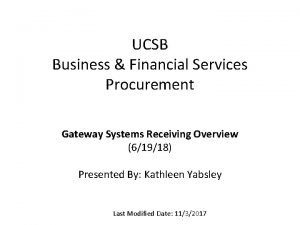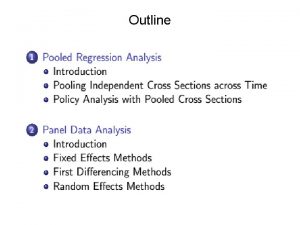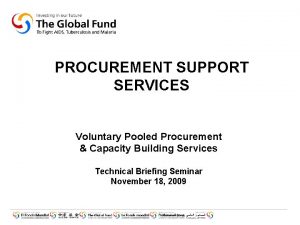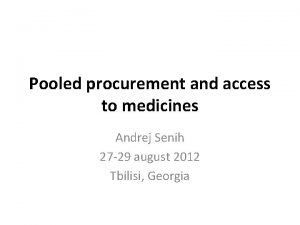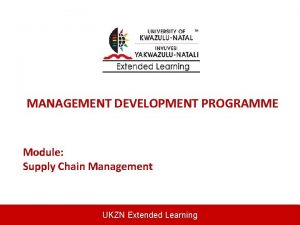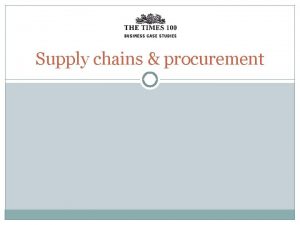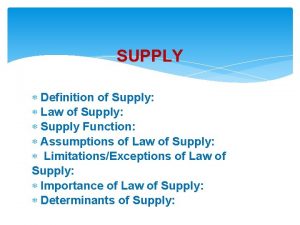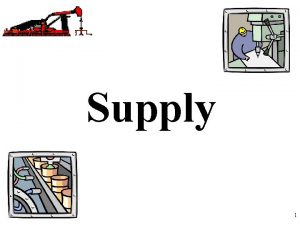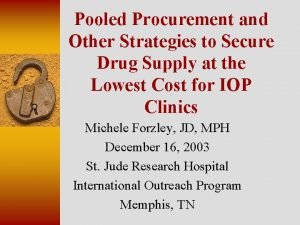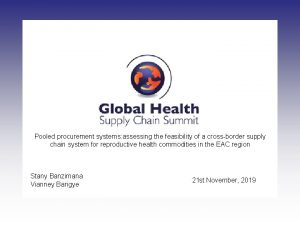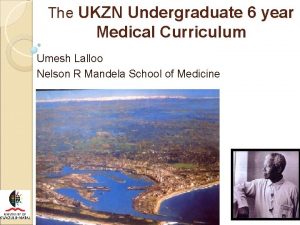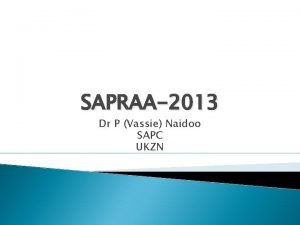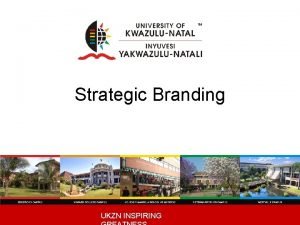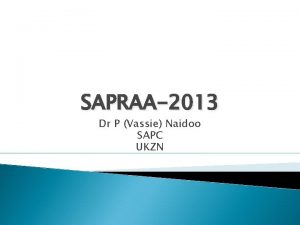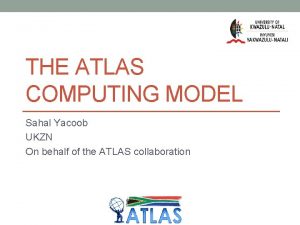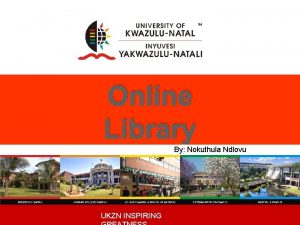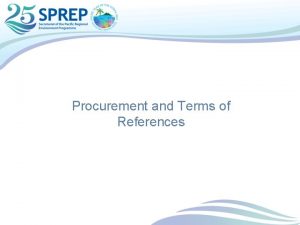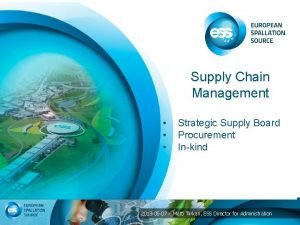PROCUREMENT SUPPLY POOLED PROCUREMENT UKZN IP Access to































- Slides: 31

PROCUREMENT & SUPPLY: POOLED PROCUREMENT UKZN IP & Access to Medicines 2009 Professor Brook K. Baker Northeastern U. School of Law Health GAP (Global Access Project) b. baker@neu. edu

Outline of Presentation • What are the principles of sound drug procurement? • What is pooled procurement? • Types of pooled procurement and their advantages and disadvantages • Where has pooled procurement worked before? • Pooled procurement in the SADC Region • Conclusion

Objectives and Operational Principles for Good Procurement • Procure the right drugs in the right quantities at the lowest possible total cost • Select reliable suppliers of quality products • Ensure timely delivery and notification • Efficient and transparent management • Drug selection and quantification • Financing and competition • Supplier selection and quality assurance

Procurement Cycle From Management Sciences for Health

Traditional Procurement Methods

Formal price can be deceptive From Management Sciences for Health

Problems with Traditional Procurement • • Non-transparency Weak bargaining power/high prices Corruption Inefficiencies, delays, and high transaction costs • Stock-outs

Alternative: Pooled Procurement • “Bulk purchasing, ” “group purchasing, ” or “pooled procurement” is defined as “purchasing done by one procurement office on behalf of a group of facilities, health systems, or countries. Group members agree to purchase certain drugs exclusively through the group” (WHO 1997) • Pooled procurement can be done by any number of parties, would not need to involve all SADC countries

Pooled Procurement – Advantages • Can create economies-of-scale market-buyingpower incentives to generic producers. • Monopsony (single buyer) purchasing power in price negotiations. • Can lead to harmonizing standard treatment guidelines (STGs), essential medicines lists (EMLs), and registration standards • Can lead to improved quality assurance and supplier monitoring • Can reduce overall transaction costs.

Pooled Procurement Disadvantages • Complicated matrix of national patent and registration rules and the mixed patent/registration status of a given medicine in different countries. • Plethora of donor procurement rules and new international procurement entities. • Regional procurement risks undermining efficient and important domestic pharmaceutical capacity. • Single-source selection (disfavoured) could lead to market concentration.

DIFFERENT OPTIONS FOR REGIONAL PROCUREMENT Informed buying • sharing information on suppliers • individual country procurement Coordinated/informed buying • joint market research, • sharing information on pricing, and joint monitoring of prices • individual country procurement Group contracting • joint selection of suppliers, • joint negotiation of prices & agreement on suppliers • individual country purchasing Central contracting • joint conducting of tenders and awarding of contracts by a central organisation formed by member countries Selective use of new donor and multilateral procurement systems (UNITAID, US SCMS, UNICEF, Global Fund VPP) Stock-out service (IDA-type facility)

Informed Buying (sharing information on suppliers but individual country procurement) Advantages Disadvantages • Increased price transparency increases options for accessing lowest price suppliers and negotiating price reductions with favored suppliers. • Although transparency increases bargaining power, it does not result in economies of scale. • Keeping information updated and accessing information frequently has transaction costs. • Price transparency between competitors can lead to de facto price fixing.

Coordinated/Informed Buying (joint market research, sharing of information on pricing, and joint monitoring of prices but individual country procurement) Advantages Disadvantages • Increased price transparency increases options for accessing lowest price suppliers and negotiating price reductions with favored suppliers. • Reduces information gathering and monitoring transaction costs. • Although transparency increases bargaining power, it does not result in economies of scale. • Price transparency between competitors can lead to de facto price fixing.

Group Contracting (joint selection of suppliers, joint negotiation of drug prices, joint agreement to procure from suppliers, but individual country procurement) Advantages Disadvantages • Increased opportunities for negotiating price reductions with multiple low cost suppliers. • Aids supplier forecasting and security of adequate supplies. • Allows use of local, capacitated procurement system. • Allows procurement of products meeting domestic patent and registration requirements. • Some unpredictability of market forecasting for suppliers leading to higher prices (based on risk). • Choosing too few suppliers can create problems in sustainability of supply and market withdrawal. • Collusion between competitors can lead to price fixing.

Central Contracting (joint conducting of tenders and awarding of contracts by a central organisation formed by member countries) Advantages Disadvantages • Greatest economies of scale and increased bargaining power. • Aids supplier forecasting and security of adequate supplies. • Reduced/shared transaction costs for procurement system. • Incentivizes harmonization of drug access policies (product registration/labeling, regional C. L. schemes) • Choosing too few suppliers can create problems in sustainability of supply and market withdrawal. • Can be much harder based on domestic patent- and registration-related issues in different countries. • Potentially weakens domestic procurement capacity/systems especially if disease-specific.

Selective Use of New Donor-Based and Multilateral Procurement Systems (UNITAID, US SCMS, UNICEF, GF) Advantages Disadvantages • Even greater economies of scale and increased bargaining power. • Aids supplier forecasting and security of adequate supplies. • Greatly reduces regional transaction costs. • Incentivizes harmonization of drug access policies (product registration/labeling, regional C. L. schemes) • Choosing too few suppliers can create problems in sustainability of supply and market withdrawal. • Can be complicated by patent and registration issues in different countries. • Potentially weakens domestic and regional procurement capacity/systems, especially if disease-specific.

Stock-Out Service (IDA-type facility) Advantages Disadvantages • Reduces need for domestic buffer stocks and reduces the risks associated with imperfect forecasting. • Compensates for unanticipated interruptions of supply from major supplier(s). • Facilitates adherence and reduces drug resistance. • Could result in reduced care in forecasting needs. • Countries could forego or reduce domestic buffer stocks to lower than desirable levels. • Potential stock-outs by the stock-out service. • Change in medication could disrupt patient adherence.

Summary of Pooled Procurement Initiatives (A. Barraclogh, MSH) PAHO Vaccine Formed OECS GCC Arab Maghreb Union Year established 1979 (23) 1986 (6) 1976 (26) 1988 (12) 1999 (3) Status Ongoing Defunct Ongoing Inactive (2000) Ongoing Number of countries 41 (2001) 6 7↑ 9 6 5↓ 3 8 Number of items 11 (2001) 20 700 (2006) 1, 127 Info not available 30 Annual volume of purchases USD 130 USD 4 M USD 3. 5 M (2001) (1987) M (2002) USD 234. 5 M (2001) Info not available Savings affected 312– 452% 30% 15– 20% 10– 96% 26– 75% 44% Pacific Islands

COST-SAVINGS CARICOM Percentage Cost-savings from pooled procurement for 25 class “A” items, 1998 - 2002 Year 1998 1999 2000 2001 2002 % Costsavings 39. 7 38. 2 37. 1 25. 2 44 Average 1998 – 2002 37%

But, Bulk Procurement has not Produced Savings for ARVs • Findings: Large purchase volumes did not necessarily result in lower ARV prices. Although current plans for pooled procurement will further increase purchase volumes, savings are uncertain and should be balanced against programmatic costs. • Third-party negotiation by [Clinton Foundation] resulted in lower generic ARV prices. • Generics were less expensive than differentially priced branded ARVs, except where little generic competition exists. • Alternative strategies for reducing ARV prices, such as streamlining financial systems, improving demand forecasting and removing barriers to generics, should be explored. • Waning, WHO Bulletin (2009)

Critical Success Factors • Political will and financial commitment • Adherence to monopsony (large-scale buying) • Secure & trustworthy finance and payment mechanism • Permanent and autonomous procurement secretariat • Harmonization of drug regulation • Good pharmaceutical procurement practices • Effective quality assurance

Pooled procurement in SADC Region • • Which is the most appropriate and practical model for cost efficient pooled procurement in the SADC region? What steps must be taken by each country to ensure that pooled procurement in the SADC region is successful? How should the existing procurement & distribution channels in member countries be upgraded in terms of: • (a) skills; and • (b) technology to accommodate an efficient pooled procurement mechanism?

Pooled Procurement in SADC Region o In SADC region, pooled procurement being driven by DFID, WHO and SADC o DFID has consulted a number of stakeholders in SADC and will be outsourcing TA and capacity building o Ambitious business plan for the harmonization of treatment regimes, medicine regulations, IP laws over 7 year period

SADC Pooled Procurement Initiative SADC Pharmaceutical business plan objectives: • (a) Harmonizing standard treatment guidelines and essential medicine lists; • (b) promoting local and regional pharmaceutical industry of generic essential medicines and African Traditional Medicines; • (c) Strengthening regulatory capacity and distribution of basic pharmaceutical products by having functional regulatory authority with enforcement infrastructure; • (d) Promoting joint procurement of medicines of acceptable safety, proven efficacy and quality to the people who need them most at affordable prices.

SADC Pooled Procurement Initiative • e) Establishing a regional databank of traditional medicine, medicinal plants and procedures; • f) Developing and retaining competent human resources for the pharmaceutical programme; • g) Developing mechanisms to respond to emergency pharmaceutical needs of the region; and • h) Facilitate the trade in pharmaceuticals within SADC

Pooled procurement in SADCopportunities • Regional market, estimated in 2000 at U$2. 5 - 3 billion, probably twice as big now. • An estimated U$1 -2 billion per year is used in public sector procurement. • achievable efficiency gain of 5% can translate into U$50 -100 million savings per year. • Advanced medicines quality assurance systems in some countries can be used to develop capacities in others – S. Africa is now considered to be a stringent drug regulator. • Improved efficiency in supply chain management systems through regional collaboration.

Preliminary Steps • SADC Health Policy Framework, SADC • Protocol on Health, the SADC Trade Protocol, Pharmaceutical Programme to guide member states • All SADC Member States have official or draft medicines policies and laws • Existence of the Pharmaceutical Regulatory Shared Network • All countries in SADC region are WTO members • SADC region has developed pharmaceutical guidelines for medicines regulation

SADC Challenges • Wide differences in capacities of 14 SADC states • Outdated medicines and intellectual property laws • Inconsistent regulatory systems and capacities, concerns about quality, safety and efficacy of medicines • Disparities between private medical aid and stated funded health care resulting in inequities • A complicated matrix of national patent and registration rules in SADC countries present real challenges to regional procurement.

SADC Challenges • Donor rules and new procurement entities further complicate regional procurement leading to procurement fragmentation • Lack of effective management information and evidence-based decision-making • Lack of harmonized pricing policies and substantial variation in prices of essential medicines for the same or similar products both within and between countries • Harmonization needed to ensure efficient use of limited resources and to avoid duplication/delays

External Threats to Pooled Procurement • Unethical promotional activities by pharmaceutical manufacturers. • Production of substandard/counterfeit medicines. • Unethical inspection and registration of medicines and premises. • Corruption in the procurement processes and in distribution systems. • Irrational prescribing and dispensing practice. • User fees and cost-recovery

CONCLUSION • Efficiencies in drug procurement are complicated by: – Patent rules and availability/use of TRIPS-compliant flexibilities – Registration status of more affordable generic equivalents (avoidance of D. E. /linkage) – Balancing of risks and benefits of various forms of regional pooled procurement • Unless African countries cooperate, they cannot achieve their individual health goals and commitments.
 Ukzn physiology modules
Ukzn physiology modules Psycholgy
Psycholgy Standard error of difference
Standard error of difference Pooled time series
Pooled time series Pooled interdependence
Pooled interdependence Florida statute 718 pooled reserves
Florida statute 718 pooled reserves H test
H test Ability 360 locations
Ability 360 locations Pooled negotiating power
Pooled negotiating power Pooled standard deviation
Pooled standard deviation Contoh teknologi craft
Contoh teknologi craft Pooled variance estimate formula
Pooled variance estimate formula Pooled negotiating power
Pooled negotiating power Contoh data pooling
Contoh data pooling 20 sentences with subject and predicate
20 sentences with subject and predicate Pooled variance estimate formula
Pooled variance estimate formula Pooled cross section
Pooled cross section Difference between rdp and sdp
Difference between rdp and sdp The procurement and supply manager's desk reference
The procurement and supply manager's desk reference Terminal access controller access control system
Terminal access controller access control system Terminal access controller access-control system
Terminal access controller access-control system Chapter 5 section 1 supply
Chapter 5 section 1 supply Ano ang ratio ng elastisidad
Ano ang ratio ng elastisidad Matching supply and demand in supply chain
Matching supply and demand in supply chain Chicago public schools bids
Chicago public schools bids Alternative mode of procurement
Alternative mode of procurement Innovation procurement european commission
Innovation procurement european commission Procurement of consultancy services
Procurement of consultancy services Summary of public procurement act, 2007
Summary of public procurement act, 2007 Types of sell side e commerce
Types of sell side e commerce Material management planning and procurement
Material management planning and procurement Business and financial services ucsb
Business and financial services ucsb

